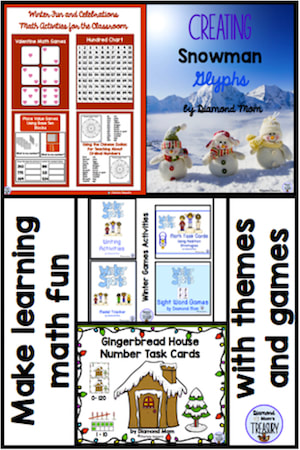|
If you want excitement, watch how kids react to the first sign of snow. When I woke up a few days ago, there was a light dusting of snow on the ground. Little did I know when I headed to school, it would be a few inches by lunch time. The kids kept looking out the window and watching the clock waiting for recess break so they could get outside and play. Of course this meant allowing more time for bundling up and preparing to go outside, then unbundling and dealing with snowy gear when they came back inside, as well as the many stories they had to tell about playing in the snow. Teachable MomentsTeachable moments are rampant at times like this. I like to use these events as springboards into different activities. You can still meet requirements of the curriculum by adding them in, they just have a fun twist to capture the excitement and focus of the kids. I learned early on to take advantage of this excitement instead of trying to squash it so that they could get back to work. Here are a few different ideas that I would do. Story telling and writingI would build in time to allow them to share their stories and then I would use that to help them write stories. Story writing using the fun activities they did outside can help even the most hesitant writer to put pen to paper. Once I had my class imagine what it would be like if the city froze. We talked about all kinds of crazy scenarios and possibilities and after brainstorming as a group, each person did some more brainstorming on their own. Then, they wrote stories and tried to add in many details and descriptive words to paint the picture in the reader's mind. Sharing the stories later was so much fun. Here is the template we used for the stories. Grab a free copy of Frozen templates by subscribing to my newsletter. Math And Science ActivitiesSometimes, I would take a math or science approach. This might include measuring the snow, seeing how long it takes to melt when brought inside, building a fort outside, seeing who can throw a snowball the farthest, making snow families, or checking the temperature at different times of the day to see if it gets colder or warmer. Snow AlternativesIf you live in a place that doesn't get snow, you could try doing some activities that might mimic those we did. For example: Use rolled up socks as pretend snowballs and see who can throw them the farthest. Shave up some ice and form snowballs and try to make a small snowman. Use ice cubes to build small forts Check the temperatures in different parts of the world for a few days in a row and then graph the results. Imagine what a snow day would be like and write about it. There are several winter language and math activities that you can do, but adding in the real life moments just makes them so much more fun. Here are some other winter resources that might be of interest as the cold, white days continue. Winter Sports Bundle Winter Word Work Language Activities Winter Parts Of Speech Silly Sentences For lots more ideas, check out my winter math and literacy category. Winter novel studies are also a great way to include a winter theme into your language arts. Here are some novel studies that might interest you. Emma's Magic Winter The Kids In Ms. Coleman's Class - Snow War Stone Fox Horrible Harry And The Holidaze Grab the excitement and wonder of winter and add it to your lessons for more engagement and motivation. I would love to hear some of the other ways you weave winter into your lessons. Don't forget to grab your free copy of Frozen writing templates. Related Posts
0 Comments
Leave a Reply. |
About Me Charlene Sequeira
I am a wife, mother of 4, grandmother of 9, and a retired primary and music teacher. I love working with kids and continue to volunteer at school and teach ukulele. Categories
All
|















 RSS Feed
RSS Feed